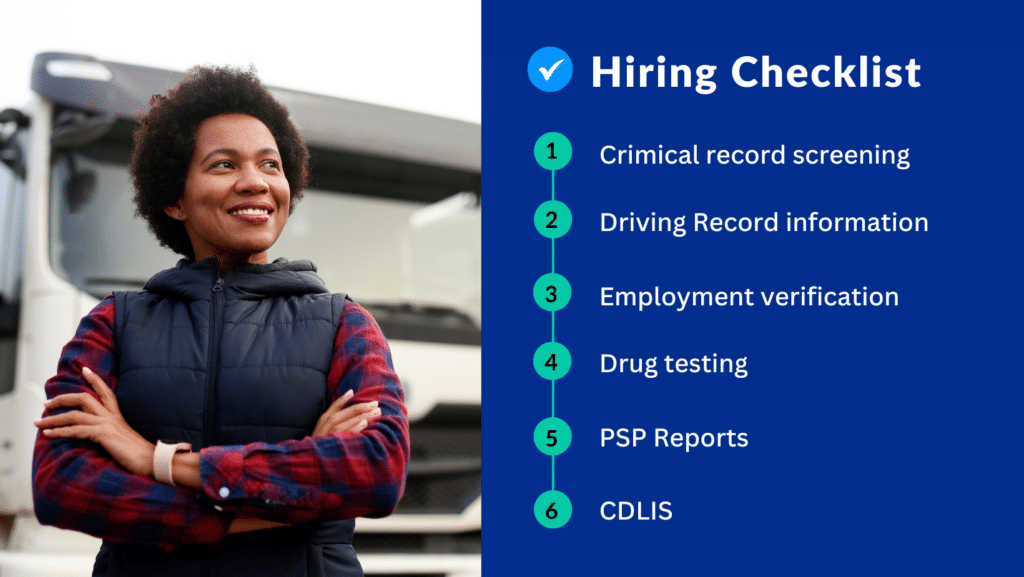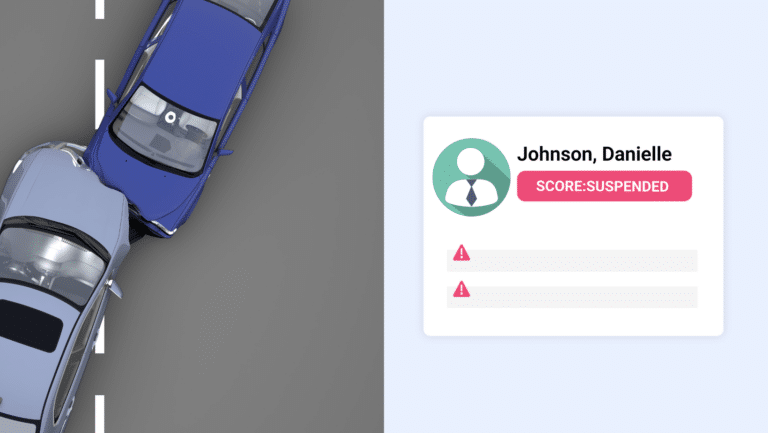A Guideline To Develop a Solid Fleet Safety Program

Unsafe driver behavior is a persistent problem that keeps fleet managers up at night, and with good reason. Fleet accident costs can be astronomical, as evidenced by recent verdicts, such as the staggering $1 billion case.
The safety of your team is closely tied to the efficiency of your fleet program. A well-structured program can significantly reduce the risk of accidents and injuries, protecting drivers and company assets.
If you’re unsure where to begin, this guideline is a solid starting point to develop and improve your fleet safety program.
What is a Fleet Safety Program?
A fleet safety program is a set of policies, procedures, and initiatives designed to promote safe driving practices and minimize risks within a fleet. A complete fleet safety program includes various elements such as driver selection, training, vehicle maintenance, safety monitoring systems, and accident prevention measures.
The primary goal of a fleet safety program is to protect drivers, passengers, pedestrians, and company assets by reducing the likelihood of accidents and injuries.
According to the National Safety Council, employers can expect a $3 to $6 return for every $1 invested in safety.
Getting Started With Your Fleet Safety Program
1. Assess Your Current Safety Measures
Before creating a new fleet safety program or updating your current one, take stock of your current safety measures. Review accident reports, compliance records, MVR violations, and driver behavior data to identify areas of concern. Understanding your current situation will enable you to pinpoint where you most need improvements.
2. Establish Clear Safety Goals
With that information in hand, it’s time to create 2-3 safety goals to address the abovementioned problem areas. These goals should be specific, measurable, achievable, relevant, and time-bound (SMART). They can range from decreasing your CSA Score, improving driver behavior, or reducing accidents and near misses. Here are some examples:
- Reduce the number of accidents involving fleet vehicles by 15% within the next year.
- Improve driver compliance with safety policies by 10% in six months.
- Decrease CSA score by 12 points by year-end.
3. Develop Comprehensive Safety Policies and Procedures
Based on your safety goals, develop clear and comprehensive safety policies and procedures that outline expectations for driver behavior, vehicle maintenance, and operational protocols. Ensure effective communication of these policies to all drivers and staff members.
Re-evaluate your hiring process
Building a successful fleet driver program starts with hiring the right people. Your drivers are the backbone of your fleet, and ensuring you have the best team possible is crucial.
Take a fresh look at the job requirements for fleet drivers. Are there any skills or qualifications that need to be added or updated? Consider any changes in technology or regulations that may require updates to your hiring criteria.
Enhance your interview process to dig deeper into candidates’ backgrounds and qualifications. Ask specific questions about their experience with safety protocols, driving record information, and their approach to handling challenging situations on the road. Find 27 of the best questions to ask a driver during an interview.

Introduce additional screening measures to ensure you’re attracting the best candidates. Ensure your hiring checklist includes driving record checks, criminal record screening, PSP reports, CDLIS, employment verification, and drug testing. Additionally, behavioral assessments or skills tests should be considered to assess candidates’ suitability for the role. Read more: PSP vs. CDLIs vs. MVRs: What’s The Difference?
Operational protocols
When managing a fleet, it’s essential to consider several factors to maintain safety and compliance. To achieve this, establishing clear and transparent protocols is crucial. To help you improve your existing fleet safety program, here are some suggestions for areas you may want to reevaluate.
Motor Vehicle Records
- Identify all individuals responsible for driving on behalf of your organization, whether they are designated fleet drivers or sales representatives using their own vehicles.
- Designate who within your organization can request and review MVRs, including fleet managers and safety or HR employees.
- Determine the frequency of Motor Vehicle Record (MVR) checks for all drivers, whether they are conducted annually, quarterly, or continuously. Download: Annual MVRs and MVR Monitoring Case Study
- Establish clear criteria defining the number of violations or accidents that make someone unqualified to drive for your company. Read more: Who Is a Risky Driver?
Driver Files Record-Keeping
- Clearly define roles within your team for collecting, reviewing, and updating driver files.
- Utilize a centralized and secure system, such as a dedicated driver file manager, to streamline the storage and management of driver files.
- Implement regular audits of driver files to ensure continuous compliance with internal policies and FMCSA regulations.
Vehicle Inspection
- Require drivers to conduct pre-trip inspections of fleet vehicles before each journey to identify any mechanical issues or safety concerns.
- Establish a schedule for vehicle inspections to ensure thorough assessments of key components such as brakes, tires, and fluids.
- Maintain comprehensive records of vehicle inspections, maintenance activities, and repairs performed on fleet vehicles.
Accidents Procedure
- Outline steps for drivers to take immediately following an accident, including ensuring the safety of all individuals involved and contacting emergency services if necessary.
- Specify procedures for documenting accident details, including time, location, and any injuries sustained.
- Designate responsible personnel for coordinating insurance claims and repairs for damaged vehicles.
Provide ongoing training and education
We often hear the phrase “like riding a bike” to describe skills we believe are etched into our muscle memory. Safe driving is often thought of in this way too – something we’ve mastered and can execute effortlessly. But is it? 90% of accidents are caused by human error. Like any acquired skill, safe driving can deteriorate over time if not practiced or reinforced.
Implement regular training programs to educate drivers on safe driving practices, defensive driving techniques, and regulatory compliance. Offer refresher courses and incorporate feedback from drivers to improve continuously. Read more: How Often Should I Train My Drivers?
According to the Federal Motor Carrier Safety Administration (FMCSA), driver training can reduce crash rates by 20% to 30%.
Use available safety technology
We all know that keeping an eye on every corner of your fleet can be tricky, but with the right tech, you can shine a light on those blurry spots.
Take a moment to think about those areas of your fleet operations that still feel fuzzy. Maybe it’s tracking new driver violations, or perhaps it’s monitoring vehicle maintenance needs more effectively. Whatever it is, pinpoint those blind spots so you can find a solution.

Invest in technology and tools that support safe driving practices, such as telematics systems, dashcams, and MVR Monitoring software. These tools can provide valuable insights into driver behavior, vehicle performance, and compliance with safety protocols.
Do some research to find the safety tech solutions that best fit your fleet’s needs. Look for user-friendly options that integrate seamlessly with safety goals. Don’t be afraid to reach out to vendors for demos or trials to see how their tech works in action. To learn more about MVR Monitoring, you can book a demo here.
Communicate and reinforce safe driving rules
Keep safe driving practices in mind by providing regular reminders to your drivers. Post safety tips in common areas, send out safety-themed newsletters or incorporate safety messages into daily communications.
Reinforce the importance of safety by highlighting key policies such as seat belt usage, speed limits, and cell phone restrictions. Share real-life examples of situations that have happened in the past as learning opportunities. Emphasize that safety is non-negotiable and that adherence to these policies is essential for everyone’s well-being.
Read more: What to include in a company vehicle policy.
4. Review, Improve, Repeat
With new technologies, regulations, and best practices emerging regularly, reevaluating your fleet driver program allows you to stay up-to-date with these changes and adapt your policies and procedures accordingly. What worked well in the past may no longer be effective or relevant today. No fleet safety program is perfect, and there’s always room for improvement.
By regularly evaluating your fleet safety program, you can pinpoint areas for improvement to enhance safety, efficiency, and cost-effectiveness. Whether it’s refining training programs, implementing new technology, or streamlining processes, continuous improvement is key to staying ahead of the curve.
Are you looking to streamline your fleet safety program’s driving record review? Contact us to discover how MVR Monitoring technology can effectively mitigate driver risk and enhance your company’s safety measures.
*We are not lawyers. Consult with your legal counsel to ensure your processes and procedures meet/ or exceed safety standards and compliance regulations. Please read our legal disclaimer.






